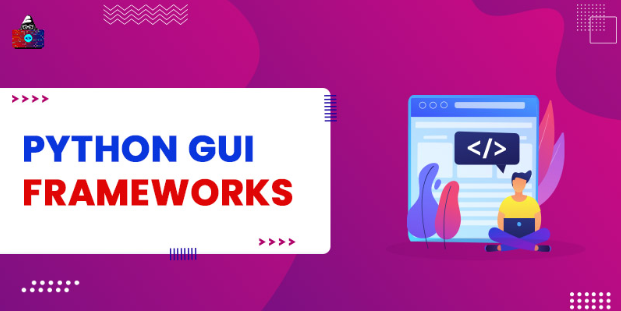Graphical user interfaces, or GUIs, are the doorway to interesting user experiences in the dynamic field of software development. Python, which is praised for being easy to use and versatile, has several different GUI frameworks, each with a unique set of features and functionalities. Python GUI frameworks enable developers to create user-friendly, visually appealing interfaces that engage consumers and expedite interaction for a wide range of applications, including desktop and mobile apps. We’ll dive into the significance of Python GUI frameworks in this post, examining how they improve the user experience, speed up prototyping, ease cross-platform development, and enable developers to produce feature-rich applications. Come along for a tour around the world of Python GUI frameworks and learn about the tools that can help you achieve greater success with your software development projects.
Importance of Python GUI Frameworks –
Python GUI frameworks are essential to contemporary software development because they let programmers design graphical user interfaces (GUIs) that are both interactive and intuitive for their apps. It is possible to comprehend the significance of Python GUI frameworks from several angles:
- Improving User Experience: With the help of GUI frameworks, developers may create aesthetically pleasing user interfaces that improve the user experience as a whole. Developers can design user-friendly, intuitive interfaces by combining components like interactive widgets, menus, and buttons.
- Cross-Platform Compatibility: Cross-platform compatibility is a feature of many Python GUI frameworks, including PyQt, Kivy, and wxPython. It enables programmers to write code once and distribute it across platforms without having to make major changes. This makes it possible for developers to enhance the impact of their products and reach a larger audience.
- Swift Prototyping and Development: Python graphical user interface frameworks offer an upper-level abstraction layer that streamlines the development of GUI applications. By using pre-built components, layout managers, and event handling techniques, developers may create apps more quickly, cutting down on development costs and time to market.
- Integration with Backend Services: Developers can construct applications that communicate with databases, web services, and other external resources by using GUI frameworks that easily connect with backend services and libraries. The creation of feature-rich apps that take advantage of Python’s ecosystem and all of its possibilities is made easier by this connection.
- Accessibility and Inclusivity: With the help of GUI frameworks, programmers may create user interfaces that cater to a wide range of needs and skill levels. Through the integration of functionalities like high-contrast themes, keyboard navigation, and screen readers, developers can guarantee that their applications are accessible to all users.
Python is a popular programming language that is easy to learn and use. It is strong in many areas, such as data analysis and web development, but it may also be used for graphical user interface (GUI) creation. GUI frameworks enable programmers to easily design interactive and user-friendly apps. This article will examine eight Python GUI frameworks that can be used to create a wide range of applications, including mobile and desktop apps.
- Tkinter: Included in the standard Python distribution, Tkinter is one of the most widely used GUI frameworks for Python. It offers an easy-to-use interface that makes developing desktop apps straightforward. With so many widgets available (such as buttons, labels, text boxes, and more), Tkinter is a good choice for developing simple to moderately complicated applications. Though it is straightforward, Tkinter is capable of handling a wide range of jobs, which makes it a great option for both novice and experienced developers.
- PyQt: PyQt is a collection of Python bindings for the Qt application framework, providing a feature-rich GUI development solution. With PyQt, programmers can take advantage of all of Qt’s features to create cross-platform apps that have a native appearance and feel. For the purpose of developing complex desktop applications, PyQt offers an extensive selection of widgets, layout managers, and tools. Furthermore, PyQt is compatible with advanced capabilities like networking, multimedia, and 3D graphics, which makes it appropriate for a variety of uses.
- Kivy: Designed for touchscreen and mobile devices, Kivy is an open-source Python library for creating multitouch apps. The primary advantage of Kivy is its capacity to develop cross-platform software for Windows, macOS, Linux, iOS, Android, and iOS. Together with support for gestures, animations, and multitouch input, it offers an extensive collection of widgets and layout managers. Because of its simplicity and adaptability, Kivy is a well-liked option for Python developers who want to create mobile applications.
- PyGTK: PyGTK is a collection of Python bindings for the GTK+ toolkit that let programmers use Python to build graphical GTK+ applications. A well-liked toolkit for creating desktop apps on Linux and Unix-like platforms is GTK+. PyGTK offers a straightforward and user-friendly interface with access to a large selection of widgets and capabilities for building GTK+ apps in Python. Developers may leverage Python’s ease of use and elegance while taking advantage of GTK+’s robust features with PyGTK.
- wxPython: wxPython is a well-liked Python GUI toolkit that offers a native appearance and feel on several systems. Based on the wxWidgets C++ library, it provides an extensive collection of tools and widgets for creating desktop programmes that run on several platforms. Because of its modular architecture and comprehensive documentation, wxPython makes it simple for developers to get started and quickly create complex applications. A wide range of applications can benefit from wxPython’s support for advanced features like drag-and-drop, clipboard operations, and printing.
- PySide: PySide is a Python binding, akin to PyQt, for the Qt framework. It offers a collection of Python modules that let programmers use Qt to construct cross-platform apps. PySide provides an extensive collection of tools, layout managers, and widgets to make creating desktop apps simple. Because of its compatibility with Qt’s signal and slot architecture, developers may easily link GUI elements with application logic. PySide is a well-liked option for developers wishing to combine the capabilities of Qt with Python because of its simplicity and ease of usage.
- PyForms: PyForms is a Python framework designed to make desktop applications simple and intuitive to use. It gives developers access to a visual editor for creating GUI layouts and lets them use Python code to specify application logic. With support for custom styling and theming, PyForms provides a variety of built-in widgets and controls for building interactive user interfaces. PyForms’ user-friendly interface and quick development process make it a great option for creating lightweight desktop applications and prototyping.
- Dear PyGui: Known for its simplicity and speed, Dear ImGui is a well-liked C++ GUI library. Dear PyGui is a Python GUI framework built on top of it. A Pythonic interface called Dear PyGui makes it easy to create graphical user interfaces with little boilerplate code. With support for custom styling and theming, it provides an extensive selection of built-in widgets and tools for creating visually appealing and responsive graphical user interfaces. Dear PyGui is an excellent choice for developing high-performance desktop apps with a sleek and contemporary user interface because of its lightweight and quick runtime.
Youtube Video – Python GUI Libraries 2023 | 7 Best GUI Framework for Python | Python For Beginners | Simplilearn
To sum up, Python provides a wide variety of GUI frameworks to accommodate the different requirements and tastes of developers. There is a Python GUI framework that will work for you, regardless of your level of experience and ability to produce complex cross-platform software or basic desktop apps. With the ease of use of Tkinter’s simplicity, PyQt’s vast capabilities, and Kivy’s mobile-friendly features, these frameworks enable developers to create user interfaces that are both intuitive and aesthetically pleasing. Through investigating available alternatives and experimenting with various frameworks, developers can open up new avenues for GUI development and realize their imaginative concepts.









Leave a Reply